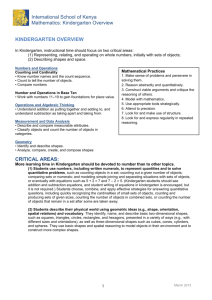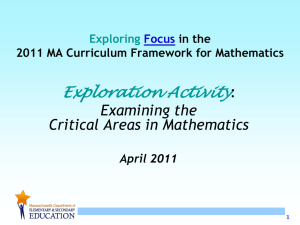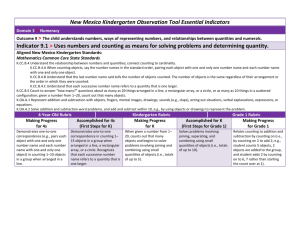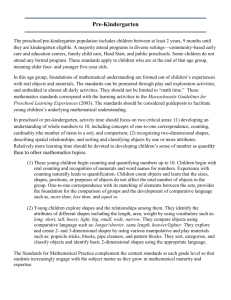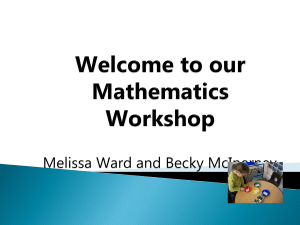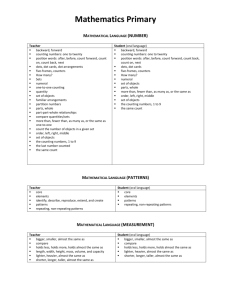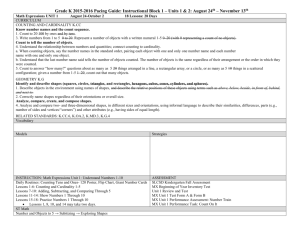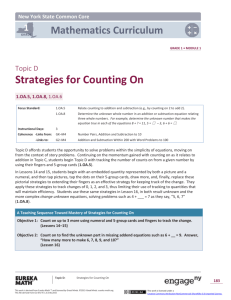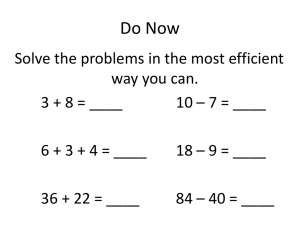WHAT STUDENTS LEARN IN Mathematics K
advertisement
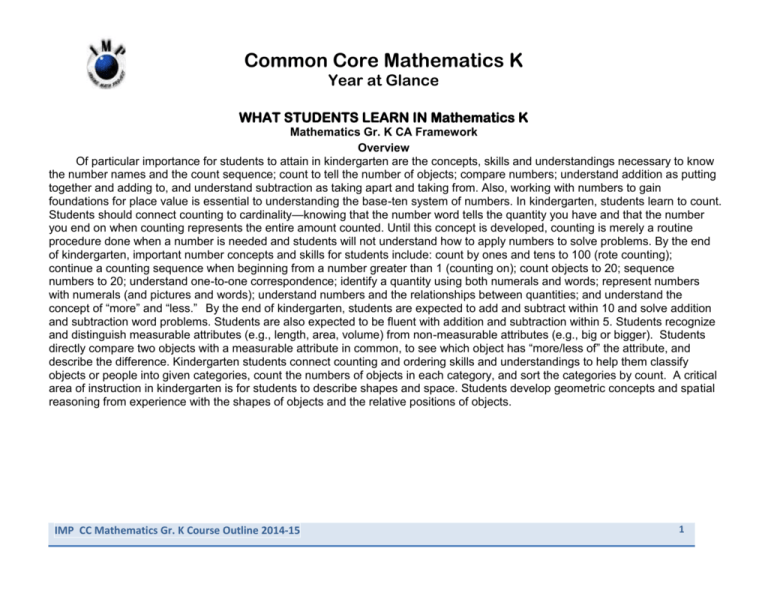
Common Core Mathematics K Year at Glance WHAT STUDENTS LEARN IN Mathematics K Mathematics Gr. K CA Framework Overview Of particular importance for students to attain in kindergarten are the concepts, skills and understandings necessary to know the number names and the count sequence; count to tell the number of objects; compare numbers; understand addition as putting together and adding to, and understand subtraction as taking apart and taking from. Also, working with numbers to gain foundations for place value is essential to understanding the base-ten system of numbers. In kindergarten, students learn to count. Students should connect counting to cardinality—knowing that the number word tells the quantity you have and that the number you end on when counting represents the entire amount counted. Until this concept is developed, counting is merely a routine procedure done when a number is needed and students will not understand how to apply numbers to solve problems. By the end of kindergarten, important number concepts and skills for students include: count by ones and tens to 100 (rote counting); continue a counting sequence when beginning from a number greater than 1 (counting on); count objects to 20; sequence numbers to 20; understand one-to-one correspondence; identify a quantity using both numerals and words; represent numbers with numerals (and pictures and words); understand numbers and the relationships between quantities; and understand the concept of “more” and “less.” By the end of kindergarten, students are expected to add and subtract within 10 and solve addition and subtraction word problems. Students are also expected to be fluent with addition and subtraction within 5. Students recognize and distinguish measurable attributes (e.g., length, area, volume) from non-measurable attributes (e.g., big or bigger). Students directly compare two objects with a measurable attribute in common, to see which object has “more/less of” the attribute, and describe the difference. Kindergarten students connect counting and ordering skills and understandings to help them classify objects or people into given categories, count the numbers of objects in each category, and sort the categories by count. A critical area of instruction in kindergarten is for students to describe shapes and space. Students develop geometric concepts and spatial reasoning from experience with the shapes of objects and the relative positions of objects. IMP CC Mathematics Gr. K Course Outline 2014-15 1 Mathematics K Year at Glance Unit Length Unit Name & Sub-topics Standards Addressed Prior Knowledge M = Major Cluster A/S = Additional or Supporting Cluster 1 Week 8/11-18/15 6 Weeks 8/18-9/26 4 Weeks 9/29-10/24 0: Introductory Week Setting the tone & Establishing Routines 1: Counting, Numerals and Cardinality Count to 100 Write numerals representing numbers 1-20 Understand one-to-one correspondence Represent a number of objects with a numeral Understand that the last number said while counting represents the number of objects, regardless of the order in which objects were counted. Given a number from 1-20, students count out objects to represent that number. Students count objects in lines, rectangular arrays, circles or scattered (up to 10 objects) Perceptual Subitizing ****Continue counting as a daily routine 2: Counting Strategies/Applications One more One less Count by 10s to 100 Compare two groups of objects up to 10 to decide which is more by matching or counting Compare two numerals from 1-10 to determine which is greater. IMP CC Mathematics Gr. K Course Outline 2014-15 CC 1, 3, 4a, 4b, 5 (ALL MAJOR) CC 2, 4c, 6, 7 (All Major) Prior unit: Counting by 1’s, writing numerals, one-to-one correspondence. 2 3 Weeks 10/27-11/14 6 Weeks 11/17-1/16 2 Weeks 1/19-1/30 Use 0, 5 and 10 as benchmark numbers for comparisons. Count on from a given starting number. ****Continue the counting strategies as a daily routine 3: Classifying and Sorting Objects Classify objects into categories. Count the number of objects in each category Sort categories by the count. 4: Addition and Subtraction within 10 Conceptual Subitizing Add and subtract within 10 using fingers, mental math, drawings, sounds, acting out, counting on or back, doubles, fact families, properties of addition, verbal explanations, expressions or equations. Solve put together and take apart word problems by using direct modeling or counting strategies. Decompose a 10 into 2 addends Make a 10 from a number 1-9 (use 10 frames to help) Demonstrate fluency in addition and subtraction within 5 Use the symbols for addition, subtraction and equal Use number bonds to represent numbers up to 10. ***Continue doing addition and subtraction situations throughout the year. K situations: Result Unknown (Add to and Take From) Total Unknown (Put Together/Take Apart), and Both Addends Unknown (Put Together/Take Apart), 5. 2-D Shapes Name 2-D regardless of their orientation. Describe the relative position of objects. Give non-examples of common shapes Know vocabulary to describe shapes such as sides and vertices. Build and draw shapes. IMP CC Mathematics Gr. K Course Outline 2014-15 MD 3 (A/S) Counting Objects Similarity and Differences OA 1, 2, 3, 4, 5 (ALL MAJOR) Counting on and back. One-to-one correspondence. G 1, 2, 3, 4, 5, 6 (ALL A/S) 3 6 Weeks 2/2-3/13 Compose shapes to make new shapes. 6: Place Value 11-19 See “teen” number as 10’s and ones Use place value cards, ten frames and dot cards to help with place value. Compose and decompose tens. Read numbers 11-19 as “one ten and __ ones” and relate this to an addition or number sentence. Use number bonds to represent numbers 11-19. NBT 1 (M) OA 3, 4a, 4b, 4c, 5 (revisit standards with numbers 11-19) Counting to 20 Representing number with objects 7: 3-D Shapes G 1, 2, 3, 4, 5, 6 (ALL A/S) Name 3-Dimensional shapes, regardless of their orientation. Identify if a shape is 2- or 3-dimensional. Give non-examples of common shapes Know vocabulary to describe shapes such as sides and vertices. Build and draw shapes. Compose shapes to make new shapes. 4 Weeks 8: Attributes MD 1, 2 Classifying objects 4/6-5/1 (All A/S) Describe measureable attributes of objects, such as by any attribute length, weight, volume, etc. Directly compare two objects to determine which has more or less of a measurable attribute. Concept that objects must share a common starting point to be able to compare measureable attributes. Concept of the conservation of length. Indicates pre-units to be taught to address standards that were taught in prior grades, but have moved grade levels and for which students need a first-teaching, or in which students need review. Pre-units may be phased out over time. 2 Weeks 3/16-3/27 IMP CC Mathematics Gr. K Course Outline 2014-15 4
